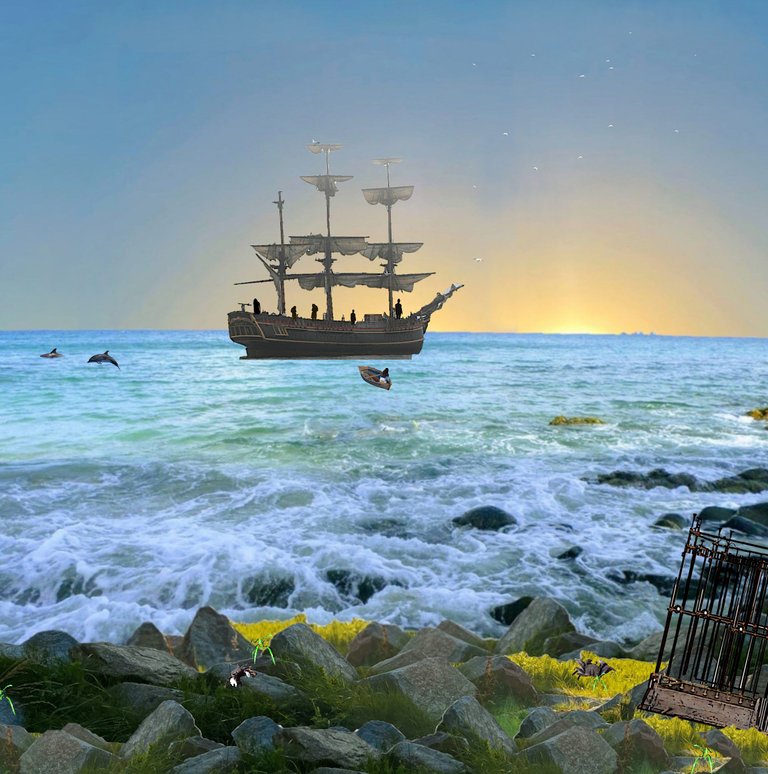
This week LMAC collage contest participants had what I thought was an interesting challenge (please note: I do not compete in the contest). The template photo suggested something sepulchral to some, including me, at first glance. But, many participants looked further and came up with other ideas.
The stunning template photo by @shaka:
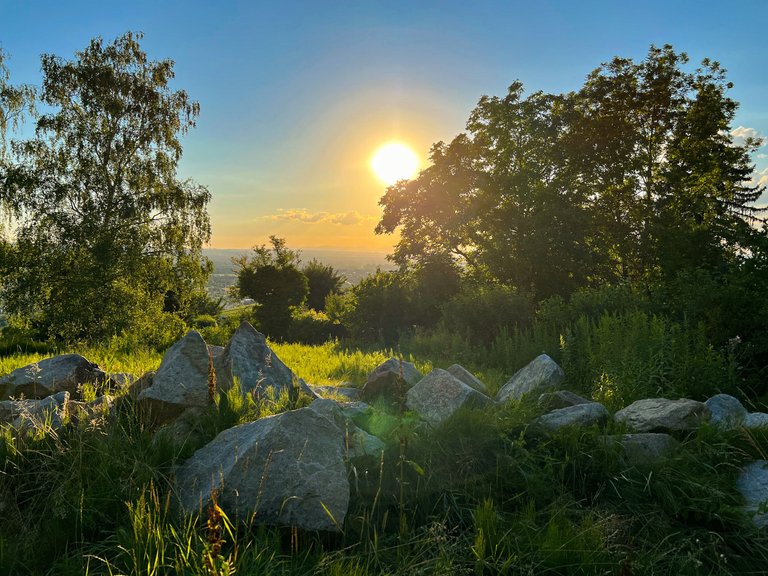
The rocks in the foreground needed attention, it seemed. What would I do with the rocks? I've been reading recently about Afro-Caribbean music. This is a living legacy of the millions of slaves who were transported from their homes in Africa to different territories in the 'New World'. I thought about the death ships that carried the kidnapped across the sea. I imagined the shore from which they departed, or one of the islands to which they were taken. The theme for my collage was fixed.
The Transatlantic Slave Trade
According to the website mediapackagescameroon, the coast of Bimbia, Cameroon is believed to have been the largest slave port in the transatlantic slave trade.
Bimbia Slave Post
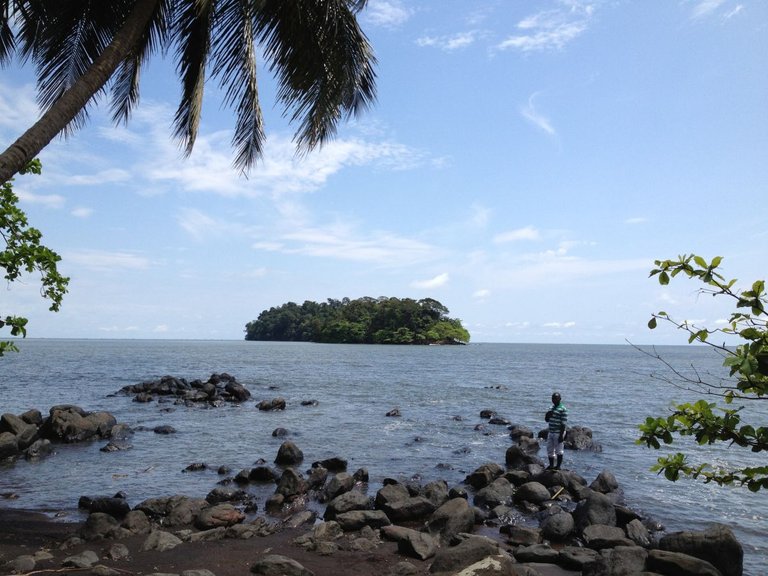
Africa Travel Association. Used under a creative commons attribution 2.0 generic license.
Henry Louis Gates, Jr, Professor of African and African American Studies at Harvard University, writes that between 1525 and 1826, the years during which the transatlantic slave trade was conducted, 12.5 million souls were captured and placed on slavers (slave ships). Only 10.7 million slaves survived the journey. The majority of the survivors did not go to North America, but rather to the Caribbean and Latin America.
Slave Trade on the African Coast by Édouard Duncan
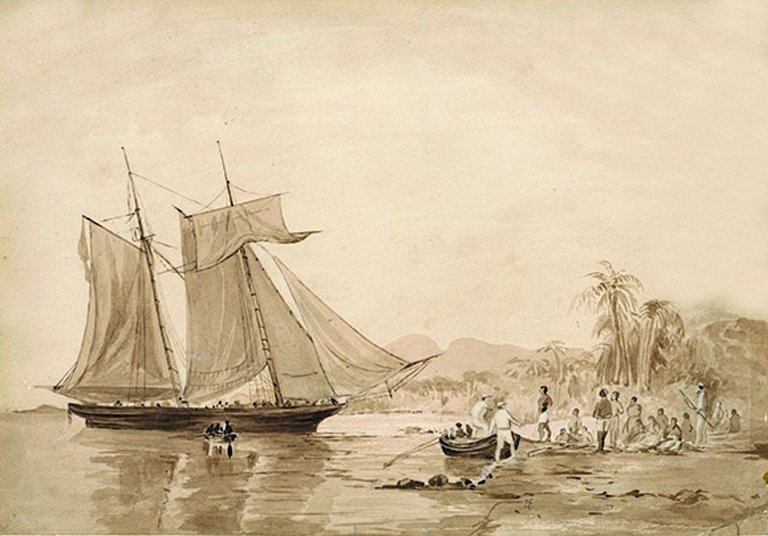
Credit: Édouard Duncan; Between 1820 and 1840. SAS Éditions du Chasse-Marée, ed. Scène de traite sur la côte d'Afrique (in fr). Retrieved on 2021-07-29. Public domain
From the few of Duncan's paintings I viewed (the ones that deal with the trade in humans), I surmise Duncan may have been part of the abolition movement in England. After a long period of engaging in the slave trade, the British finally passed a law which forbade the activity in 1807 (Abolition of Slavery Act).
The slave trade may have been forbidden by the government, but the institution of slavery still persisted in British territories. Slavery was very lucrative for Britain, which transported more slaves than any other country. 70% of the entire slave trade has been attributed to two nations, Britain and Portugal.
Slaves Cutting Cane on a Plantation in Jamaica
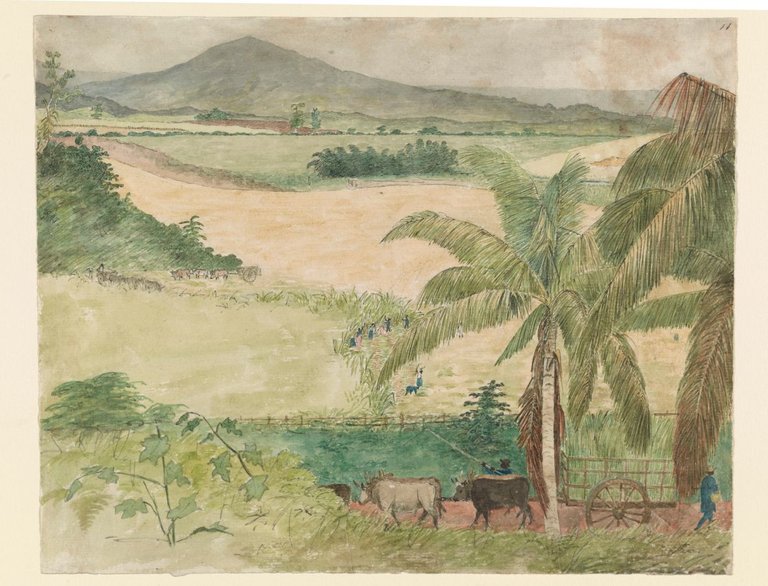
Credit: William Berryman. 1808 Public domain
Jamaica was a British colony. The British had seized it from the Spanish in 1655. At the time, slavery was well established on the island. The death of slaves in Jamaica was so common that births could not replenish the lost labor. Thus, there was constant motivation for bringing new slaves to the island in order to keep the profitable sugar cane and coffee plantations productive.
Leonard Parkinson, Captain of Maroons (Jamaica Slave Revolt)
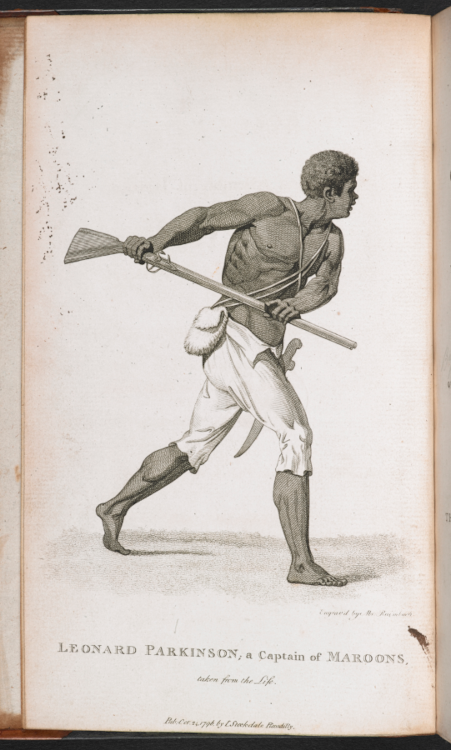
Abraham Raimbach. Engraving/etching. 1796. Public domain
The British worried about slave rebellions in those territories where slavery persisted. After the Spanish were driven out of Jamaica, the new plantation owners were forced to deal with a dedicated group of slaves who had escaped to the mountains. Called Maroons, these individuals organized into a resistance movement.
Slavery in Jamaica was abolished in 1838. This was partly a result of slave rebellion, activism by missionaries on the island, and abolitionist sentiment in the British Parliament.
Harewood House, England, Built With Fortune Earned in the West Indies
User: Gunnar Larsson. Used under Creative Commons Attribution-Share Alike 3.0 Unported. Built by the Lascelles family, owners of plantations worked by slaves in Barbados plantations.
Many distinguished members of the ruling class in Britain today can trace ancestry to owners of plantations worked by slaves during the colonial era. Britain was not the only country to earn wealth from the trade and labor of slaves, however. Among the countries that engaged in the slave trade were the French, Dutch, Spanish, Portuguese, Danes and Brazilians. Nonetheless, England dominated the slave trade.
Slave Huts in Bonaire, Dutch Antilles
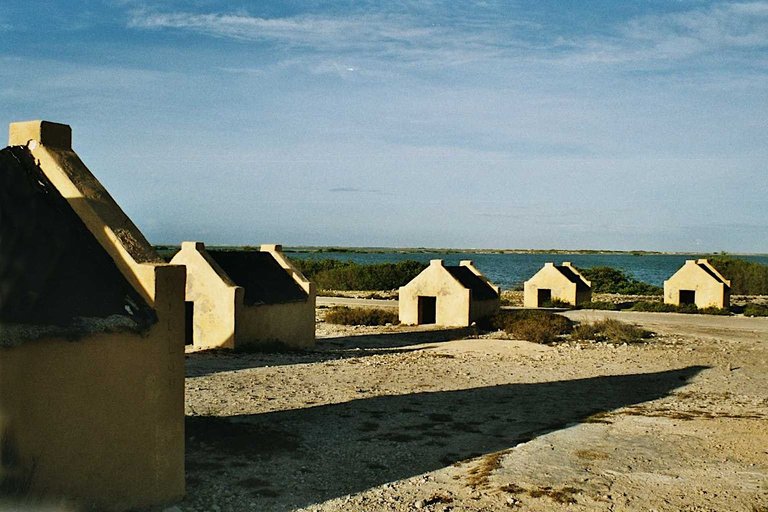
Credit: V.C. Vulto. Used under Creative Commons Attribution-Share Alike 3.0 Unported license
The slave huts shown in the photograph above were used to house slaves who worked in the salt pans (white gold) on the island. Before these huts were built, slaves had lived in the open air or wooden huts. Although the Dutch officially abolished trade in slaves in 1814, slavery as an institution continued in Dutch colonies until 1863.
Slave Baracoon in Sierra Leone
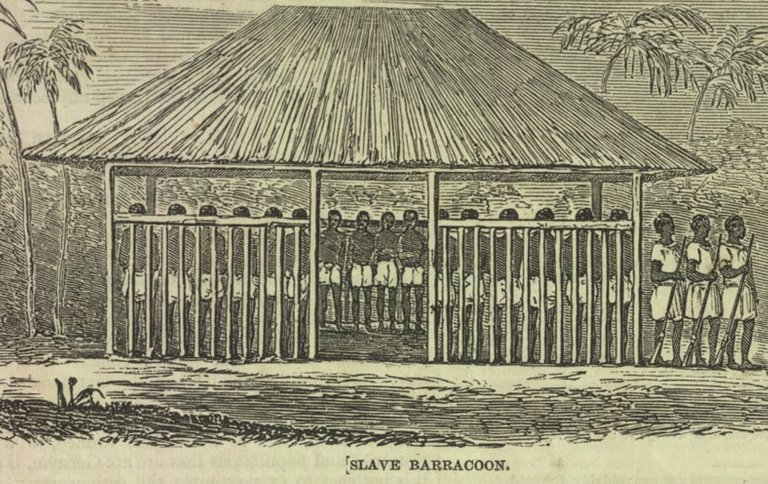
Illustrated London News, 1849 unknown author. Public domain.
As I explained earlier, the idea evolved from some of my recent readings. I did a little more research once I decided on the theme. I wanted to know what a slave ship looked like, and I wanted to know what kinds of animals might be sighted from the ship. Dolphins like to follow ships I learned. It seems they like to take advantage of the current created by the ship. Also gulls and albatrosses follow ships. These birds would be attracted to the refuse generated by those onboard.
Putting a cage on the beach seemed indelicate. I wasn't sure I should include that brutal symbol, but it does clearly represent the caging of the human beings kidnapped and transported. Canoes (smaller boats) would be used to ferry people from the larger ship to the shore (note the picture by Édouard Duncan, above).
In the making of this collage I am indebted to my Hive friends who contributed pictures to the LMAC Image Gallery, LIL. Thank you,
There were additional elements from LIL that I contributed:
silhouette
2nd silhouette
person in canoe
I am also indebted to photographers from Pixabay:
- enzol schooner
There were many, many steps to completing this collage. Here I show a few. First I had to establish the base picture in which everything else would be placed. I isolated the rocks in the foreground, from @shaka's template, and the sky/sun in the background. I combined these with @hernleon's ocean scene.

Once I had the horizon settled and leveled I started adding elements. First the schooner
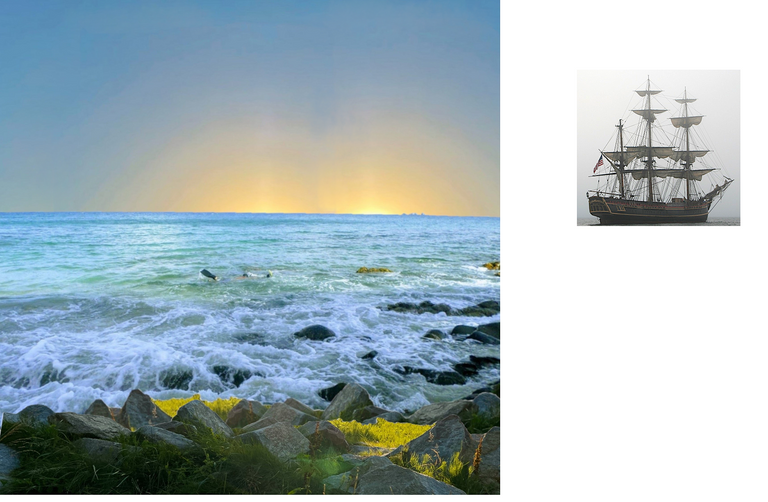
Then cage and more rocks. I eliminated the scuba diver in the foreground.
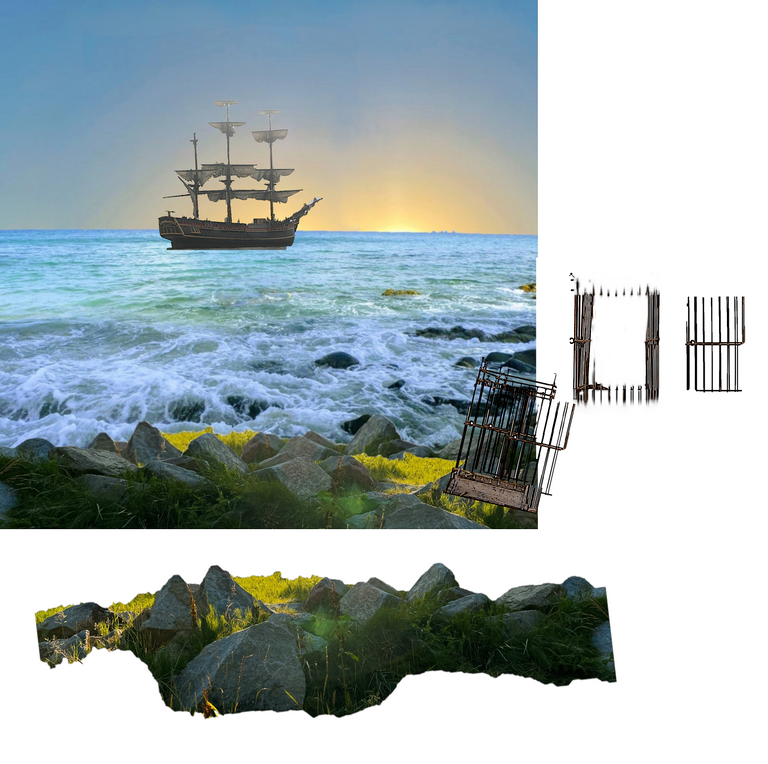
I added, successively, birds in the sky, bird on the mast, crabs, plants, canoe, person in the canoe, people on the ship and each of the dolphins.

Making collages is a fun, a creative exercise and a learning experience. This week I learned more about the era when the 'New World' was developed and the 'Old World' grew wealthy from the trade and labor of African slaves.
Please check out this week's winning collages at the LMAC community site. Tomorrow we begin another round (#162). Come back then, discover the new template, and try your hand at making something unique.
You can see that LIL, the LMAC Image Library, is an important part of my collage creating process. Everyone on Hive can contribute to the library and borrow from the library. Learn about the procedure here.
I wish all my readers peace and health.
***I'm adding one more image with a bit of animation, in case any of my readers are looking for that :)
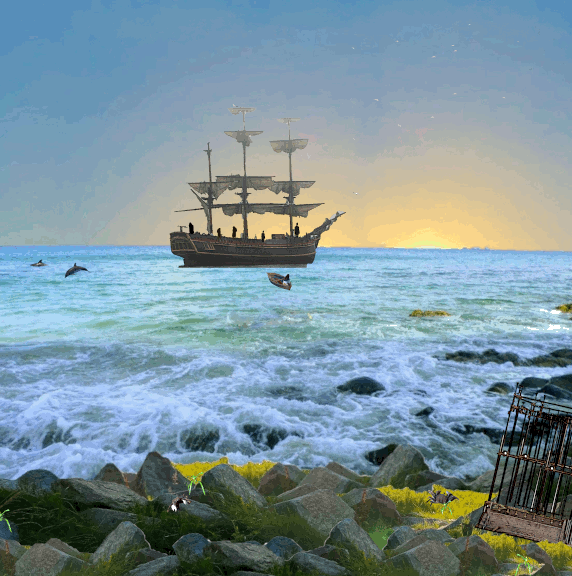
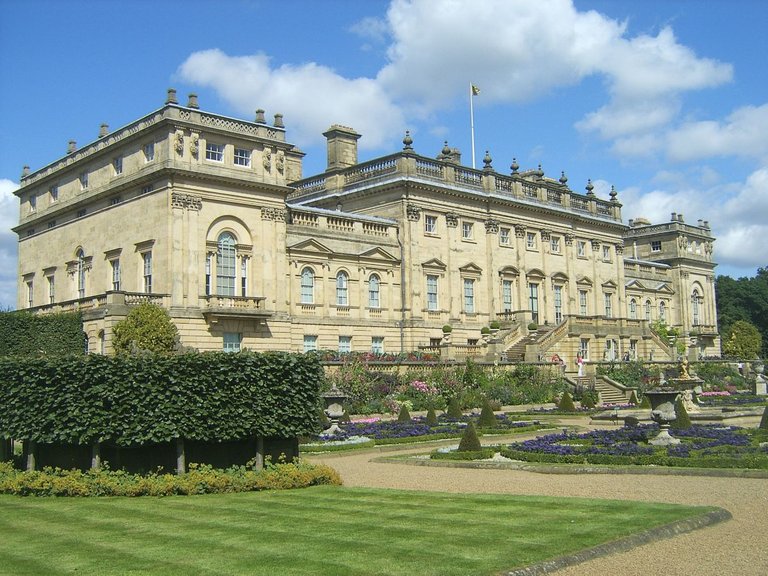
Great collage and great blog as always! You pointed out that, "Many distinguished members of the ruling class in Britain today can trace ancestry to owners of plantations worked by slaves during the colonial era." This is certainly true, but more of function of the fact that the ancestry of the ruling class in Britain is still closely correlated to the Norman invasion of 1066! (amazingly, it really does go that far back)
https://www.theguardian.com/commentisfree/2012/dec/17/high-house-prices-inequality-normans
Thank you for reading and for that quite informative comment. As always, @one-eye you make an interesting contribution to my blog.
You never disappoint:) So taken was I with the animation I didn't notice the cage until you pointed it out.
Regarding the slave trade, it surprised me to learn that hundreds of thousands of Irish were sold as slaves in the 17th, 18th, and 19th Centuries, men, women, and children. From 1641-1652 300,000 were sold to British merchantry in the West Indies and North America. We didn't learn any of that at school!
I did not know that. Of course I'm horrified, but not surprised. The English did not regard the Irish as civilized human beings.
It may have been true at one time that the sun never set on the British Empire, but it was also true that the sun never rose for those who lived under British colonial rule.
Thank you for visiting and commenting. I'm happy my simple animation amused you :)
Always a thought provoking collage and information A. G. The cage is a clue to what the ship is.
It is terrible the cruelty that humans inflict on each other. No only the Africans but the Irish were also sold as slaves.
Winter seems to be slowing down here and it’s staying above freezing. I saw on TV where places like sunny California are getting snow. Maybe the planet is tipping a bit. 😊
Have a pleasant Friday my friend. 💕
It is astonishing and yet in accord with what I have read about British colonial rule (and other countries, also).
Yes!! Nice for furry friends and humans.
Thanks for reading and appreciating my blog, my friend @redheadpei. Have a wonderful weekend.
Great look at these historical events. Unfortunately, most of the facts have been written by Europeans with particular lenses and outlooks, so it's difficult to get a good unbiased assessment of what really happened.
Were they captured or bought from already established slavers? This is a key difference that pertains to events happening today. The trade in slavery extends far into history and the mechanics of it were already in place before Europeans showed up. What is mind blowing to me is that slavery still goes on today, centuries after the practice was institutionally banned in the west. I'm not just talking about slavery in metaphorical sense but in the actual sense of the word. Today in 2023, and no one bats an eyelash.
Not only the ruling class but many others including Black Panther member Angela Davis. She has been calling for reparations, so this must be difficult information. Maybe Nietzsche was right,if you gaze long enough into an abyss, the abyss will gaze back into you.
Excellent thoughtful article and creative images!
I think this is your best yet @agmoore 🔥
The theme is a bit touchy yet it is well done.
Lovely as always ❤️✨
Thank you.
Maybe touchy but I had to write it :)
Hi agmoore, nice collage, nice animation.
It is very nourishing, but while reading the documentary, I kept thinking about all that suffering. You can't change the past, but here I realized that around 1820 many countries started to abolish slavery or part of it. At least, humanity reflects when it realizes something is wrong and tries to fix it.
One of the benefits of making a collage: We can lost ourselves in that activity. It is a healthy distraction from the other thoughts.
Thanks for stopping by and for enjoying my collage. Have a great day and have fun creating another impressive design for LMAC :)
En tu collage si hay mucha agua, te quedo espectacular como siempre, saludos amiga!
Si! 😄
Thank you for the kind words, @kiilders
The rewards earned on this comment will go directly to the people( @agmoore ) sharing the post on Twitter as long as they are registered with @poshtoken. Sign up at https://hiveposh.com.